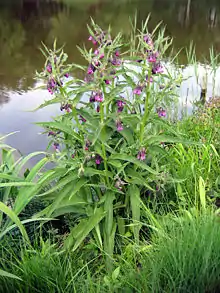Symphytum officinale
Symphytum officinale is a perennial flowering plant in the family Boraginaceae. Along with thirty four other species of Symphytum, it is known as comfrey. To differentiate it from other members of the genus Symphytum, this species is known as common comfrey[1] or true comfrey.[2] Other English names include Quaker comfrey, cultivated comfrey,[2] boneset, knitbone, consound, and slippery-root.[3] It is native to Europe, growing in damp, grassy places. It is locally frequent throughout Ireland and Britain on river banks and ditches. It occurs elsewhere, including North America, as an introduced species and sometimes a weed. The flowers are mostly visited by bumblebees.[4] Internal or long-term topical use of comfrey is discouraged due to its strong potential to cause liver toxicity.[5]
| Symphytum officinale | |
|---|---|
 | |
| Scientific classification | |
| Kingdom: | Plantae |
| Clade: | Tracheophytes |
| Clade: | Angiosperms |
| Clade: | Eudicots |
| Clade: | Asterids |
| Order: | Boraginales |
| Family: | Boraginaceae |
| Genus: | Symphytum |
| Species: | S. officinale |
| Binomial name | |
| Symphytum officinale | |
| Synonyms | |
| |
History
Over centuries, comfrey was cultivated in Asia, Europe, and the United Kingdom as a vegetable and herbal medicine.[5][6][7] Its early common names, knitbone or boneset, reflect its historical use by poultices of leaves and roots to treat sprains, bruises or bone fractures.[5][6]
Description and botany
Comfrey is a perennial plant found in moist grasslands in western Asia, Europe, and North America.[7] The hardy plant can grow to a height of 1–3 ft (0.3–0.9 m).[7] It is a perennial herb with a black, turnip-like root and large, hairy broad leaves that bears small bell-shaped flowers of various colours, typically cream or purplish, which may be striped.
A common hybrid is formed between Symphytum officinale and S. asperum, Symphytum × uplandicum, known as Russian comfrey, which is widespread in the British Isles, and which interbreeds with S. officinale. Compared to S. officinale, S. × uplandicum is generally more bristly and has flowers which tend to be more blue or violet.[8] The plant produces significant nectar when compared to other UK plants tested.[9]
Traditional medicine
In folklore, Symphytum officinale roots were used in traditional medicine internally (as an herbal tea or tincture) or externally (as ointment, compresses, or alcoholic digestion) for treatment of various disorders,[5][7][10] including commonly as a treatment for reducing the pain of osteoarthritis.[11] A 2013 review of clinical studies assessing the possible effect of comfrey on osteoarthritis found the research quality was too low to allow conclusions about its efficacy and safety.[11] In Europe as of 2015, there were no comfrey products for oral use, and those for topical uses to treat bruises or joint pain were evaluated as having risk of liver toxicity.[6]
Toxicity and adverse effects
Comfrey contains pyrrolizidine alkaloids which are toxic compounds readily absorbed via the stomach or skin, and have potential to increase the risk of fatal liver toxicity.[5][6][12] In 2001, the US Food and Drug Administration and Federal Trade Commission banned the sale of comfrey products from the market due to its potential toxicities.[13][14] A 2018 review on pyrrolizidine alkaloids present in comfrey indicated widespread potential toxicity to humans and livestock, and the opportunity for drug development from these compounds.[15]
References
- "Symphytum officinale". Natural Resources Conservation Service PLANTS Database. USDA. Retrieved 7 December 2015.
- Bareeba, F. B.; Odwongo, W. O.; Mugerwa, J. S. "The potential of Russian comfrey (Symphytum officinale) as an animal feedstuff in Uganda". Food and Agriculture Association of the United Nations.
- "Symphytum officinale". Germplasm Resources Information Network (GRIN). Agricultural Research Service (ARS), United States Department of Agriculture (USDA). Retrieved 1 January 2018.
- Van Der Kooi, C. J.; Pen, I.; Staal, M.; Stavenga, D. G.; Elzenga, J. T. M. (2015). "Competition for pollinators and intra-communal spectral dissimilarity of flowers". Plant Biology. 18 (1): 56–62. doi:10.1111/plb.12328. PMID 25754608.
- "Comfrey". Drugs.com. 2018. Retrieved 16 January 2019.
- "Assessment report on Symphytum officinale L., radix" (PDF). European Medicines Agency. 5 May 2015. Retrieved 16 January 2019.
- "Symphytum officinale". Plant Finder, Missouri Botanical Garden. Retrieved 16 January 2019.
- Stace, Clive (2010). New Flora of the British Isles (3rd ed.). Cambridge, UK: Cambridge University Press. ISBN 978-0-521-70772-5{{inconsistent citations}}, p. 557
- "Which flowers are the best source of nectar?". Conservation Grade. 2014-10-15. Retrieved 2017-10-18.
- Vogl, Sylvia; Picker, Paolo; Mihaly-Bison, Judit; Fakhrudin, Nanang; Atanasov, Atanas G.; Heiss, Elke H.; Wawrosch, Christoph; Reznicek, Gottfried; Dirsch, Verena M.; Saukel, Johannes; Kopp, Brigitte (2013). "Ethnopharmacological in vitro studies on Austria's folk medicine—An unexplored lore in vitro anti-inflammatory activities of 71 Austrian traditional herbal drugs". Journal of Ethnopharmacology. 149 (3): 750–71. doi:10.1016/j.jep.2013.06.007. PMC 3791396. PMID 23770053.
- Cameron, M; Chrubasik, S (31 May 2013). "Topical herbal therapies for treating osteoarthritis". The Cochrane Database of Systematic Reviews. 5 (5): CD010538. doi:10.1002/14651858.CD010538. PMC 4105203. PMID 23728701.
- Oberlies, Nicholas H; Kim, Nam-Cheol; Brine, Dolores R; Collins, Bradley J; Handy, Robert W; Sparacino, Charles M; Wani, Mansukh C; Wall, Monroe E (2007). "Analysis of herbal teas made from the leaves of comfrey (Symphytum officinale): Reduction of N-oxides results in order of magnitude increases in the measurable concentration of pyrrolizidine alkaloids". Public Health Nutrition. 7 (7): 919–24. doi:10.1079/phn2004624. PMID 15482618.
- "FDA Advises Dietary Supplement Manufacturers to Remove Comfrey Products From the Market". US Food and Drug Administration. 6 July 2001. Archived from the original on 14 November 2017. Retrieved 16 January 2019.
- "FTC Announces a Second Case Focusing on Safety Risks of Comfrey Products Promoted via Internet". US Federal Trade Commission. 13 July 2001. Retrieved 16 January 2019.
- Moreira, Rute; Pereira, David; Valentão, Patrícia; Andrade, Paula (5 June 2018). "Pyrrolizidine Alkaloids: Chemistry, Pharmacology, Toxicology and Food Safety". International Journal of Molecular Sciences. 19 (6): 1668. doi:10.3390/ijms19061668. ISSN 1422-0067. PMC 6032134. PMID 29874826.
External links
Symphytum officinale in the CalPhotos Photo Database, University of California, Berkeley